接受静脉体外膜肺氧合的患者肥胖重要吗?体外心肺复苏后体重指数与死亡率之间的 U 型关系。
IF 3.2
2区 医学
Q1 SURGERY
引用次数: 0
摘要
背景:肥胖对接受静脉体外膜氧合患者预后的影响仍不清楚。本研究探讨了接受静脉体外膜氧合患者的体重指数与院内死亡率之间的关系:这项回顾性研究招募了 2010 年至 2021 年期间在台湾大学医院接受静脉体外膜氧合支持(包括体外心肺复苏)的成年患者。患者的分类如下:体重过轻(体重指数结果);体重过重(体重指数结果);体重过重(体重指数结果);体重过重(体重指数结果):研究共纳入 1,329 名患者,其中 670 人接受了体外心肺复苏,总死亡率为 61.6%。多变量 Cox 回归显示,III 级肥胖与较高的死亡率显著相关(危险比 2.11,95% 置信区间 1.48-3.02,P = .001),尤其是在体外心肺复苏亚组中(危险比 2.71,95% 置信区间 1.71-4.29,P < .001)。在非体外心肺复苏亚组中没有观察到明显的关联(危险比 1.29,95% 置信区间 0.70-2.36,P = .415)。虽然体重不足的患者最初死亡率较高(危险比 1.77,95% 置信区间 1.12-2.80,P = .015),但在调整了混杂因素后,这一影响有所减弱(危险比 1.46,95% 置信区间 0.91-2.35,P = .119)。Kaplan-Meier分析表明,三级肥胖症患者的院内死亡率最高,其次是体重不足组(log-rank P = .009):结论:肥胖会增加接受静脉体外膜肺氧合患者的死亡率,但这主要是由于在接受体外心肺复苏的患者中观察到体重指数与院内死亡率呈非线性U形分布。需要进一步研究以明确这些关联的因果关系。本文章由计算机程序翻译,如有差异,请以英文原文为准。
Does obesity matter in patients receiving venoarterial extracorporeal membrane oxygenation? The U-shaped relationship between body mass index and mortality after extracorporeal cardiopulmonary resuscitation
Background
The impact of obesity on the prognosis of patients receiving venoarterial extracorporeal membrane oxygenation remains unclear. This study examines the association between body mass index and in-hospital mortality among patients on venoarterial extracorporeal membrane oxygenation support.
Methods
This retrospective study enrolled adult patients who received venoarterial extracorporeal membrane oxygenation support, which included extracorporeal cardiopulmonary resuscitation, at National Taiwan University Hospital between 2010 and 2021. Patients were classified as follows: underweight (body mass index <18.5), normal weight (18.5≤ body mass index <24), overweight (24≤ body mass index <27), class I obesity (27≤ body mass index <30), class II obesity (30≤ body mass index <35), and class III obesity (body mass index ≥35). Multivariable Cox regression with spline models was employed.
Results
The study included 1,329 patients; of these, 670 underwent extracorporeal cardiopulmonary resuscitation, and the overall mortality rate was 61.6%. Multivariable Cox regression revealed that class III obesity was significantly associated with higher mortality (hazard ratio 2.11, 95% confidence interval 1.48–3.02, P = .001), particularly in the extracorporeal cardiopulmonary resuscitation subgroup (hazard ratio 2.71, 95% confidence interval 1.71–4.29, P < .001). No significant association was observed in the non–extracorporeal cardiopulmonary resuscitation subgroup (hazard ratio 1.29, 95% confidence interval 0.70–2.36, P = .415). Although underweight patients initially exhibited higher mortality (hazard ratio 1.77, 95% confidence interval 1.12–2.80, P = .015), this effect was attenuated after adjusting the confounders (hazard ratio 1.46, 95% confidence interval 0.91–2.35, P = .119). Kaplan-Meier analysis indicated that class III obesity was associated with the highest in-hospital mortality, followed by the underweight group (log-rank P = .009).
Conclusion
Obesity increased mortality in patients who underwent venoarterial extracorporeal membrane oxygenation, but this was primarily due to a nonlinear U-shaped distribution between body mass index and in-hospital mortality observed in patients receiving extracorporeal cardiopulmonary resuscitation. Further studies are needed to clarify the causal factors underlying these associations.
求助全文
通过发布文献求助,成功后即可免费获取论文全文。
去求助
来源期刊

Surgery
医学-外科
CiteScore
5.40
自引率
5.30%
发文量
687
审稿时长
64 days
期刊介绍:
For 66 years, Surgery has published practical, authoritative information about procedures, clinical advances, and major trends shaping general surgery. Each issue features original scientific contributions and clinical reports. Peer-reviewed articles cover topics in oncology, trauma, gastrointestinal, vascular, and transplantation surgery. The journal also publishes papers from the meetings of its sponsoring societies, the Society of University Surgeons, the Central Surgical Association, and the American Association of Endocrine Surgeons.
 求助内容:
求助内容: 应助结果提醒方式:
应助结果提醒方式:


